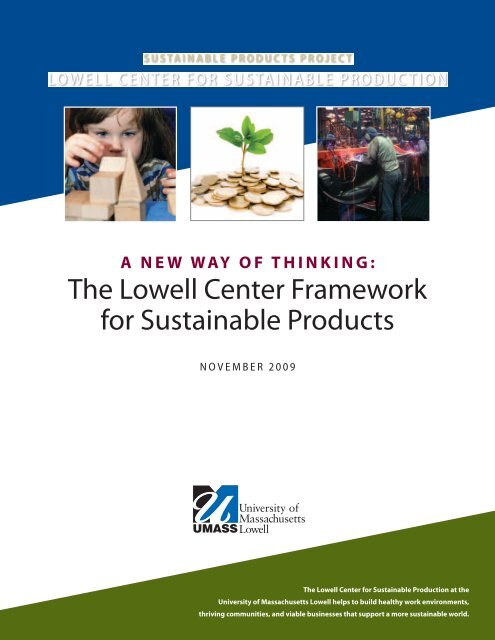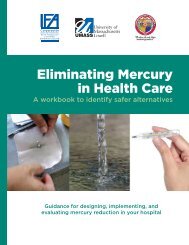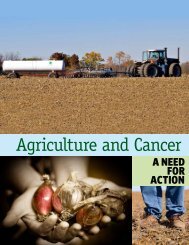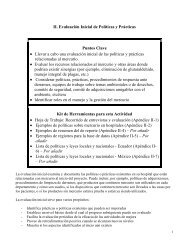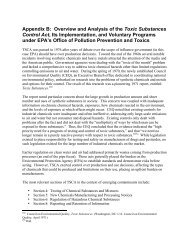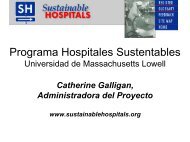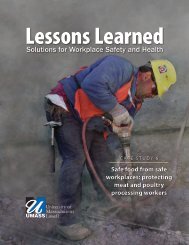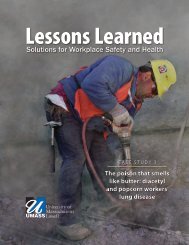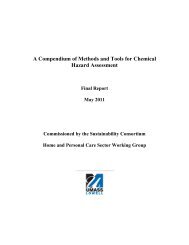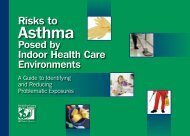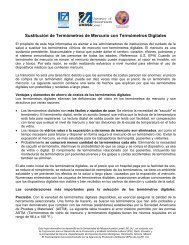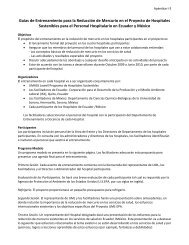Download - The Lowell Center Framework for Sustainable Products
Download - The Lowell Center Framework for Sustainable Products
Download - The Lowell Center Framework for Sustainable Products
Create successful ePaper yourself
Turn your PDF publications into a flip-book with our unique Google optimized e-Paper software.
sustainable products project<br />
LoweLL <strong>Center</strong> <strong>for</strong> SuS tainabL e ProduC tion<br />
A New wAy of ThiN kiN g:<br />
<strong>The</strong> <strong>Lowell</strong> <strong>Center</strong> <strong>Framework</strong><br />
<strong>for</strong> <strong>Sustainable</strong> <strong>Products</strong><br />
n ovember 2009<br />
<strong>The</strong> <strong>Lowell</strong> <strong>Center</strong> <strong>for</strong> <strong>Sustainable</strong> Production at the<br />
University of Massachusetts <strong>Lowell</strong> helps to build healthy work environments,<br />
thriving communities, and viable businesses that support a more sustainable world.
2 | <strong>Lowell</strong> <strong>Center</strong> <strong>for</strong> <strong>Sustainable</strong> Production | University of Massachusetts <strong>Lowell</strong><br />
Author<br />
Sally edwards, Sc.D – Research Associate, <strong>Lowell</strong> <strong>Center</strong> <strong>for</strong> <strong>Sustainable</strong> Production,<br />
University of Massachusetts <strong>Lowell</strong><br />
In 2009, the <strong>Lowell</strong> <strong>Center</strong> convened a work group to share insights about current projects,<br />
develop a vision <strong>for</strong> our ef<strong>for</strong>ts on sustainable products, and contribute to this document.<br />
University of Massachusetts <strong>Lowell</strong> participants included:<br />
Monica Becker, MS – Fellow, <strong>Lowell</strong> <strong>Center</strong> <strong>for</strong> <strong>Sustainable</strong> Production<br />
Melissa Coffin, MA – Research Associate, <strong>Lowell</strong> <strong>Center</strong> <strong>for</strong> <strong>Sustainable</strong> Production<br />
Cathy Crumbley, MA – Program Director, <strong>Lowell</strong> <strong>Center</strong> <strong>for</strong> <strong>Sustainable</strong> Production<br />
Pam eliason, MS –Industry Research Program Manager, Toxics Use Reduction Institute<br />
Liz harriman, MS – Deputy Director, Toxics Use Reduction Institute<br />
ken geiser, PhD, Co-Director, <strong>Lowell</strong> <strong>Center</strong> <strong>for</strong> <strong>Sustainable</strong> Production<br />
Pia Markkanen, ScD – Research Professor, <strong>Lowell</strong> <strong>Center</strong> <strong>for</strong> <strong>Sustainable</strong> Production<br />
greg Morose, ScD – Industry Research Project Manager, Toxics Use Reduction Institute<br />
Joel Tickner, ScD – Director, Chemicals Policy and Science Initiative,<br />
<strong>Lowell</strong> <strong>Center</strong> <strong>for</strong> <strong>Sustainable</strong> Production<br />
yve Torrie, MA—Project Manager, <strong>Lowell</strong> <strong>Center</strong> <strong>for</strong> <strong>Sustainable</strong> Production<br />
Jessica Schifano, JD, MPh – Policy Analyst, <strong>Lowell</strong> <strong>Center</strong> <strong>for</strong> <strong>Sustainable</strong> Production<br />
<strong>The</strong> <strong>Lowell</strong> <strong>Center</strong> <strong>for</strong> <strong>Sustainable</strong> Production uses rigorous science, collaborative research,<br />
and innovative strategies to promote communities, workplaces, and products that are healthy,<br />
humane, and respectful of natural systems. <strong>The</strong> <strong>Center</strong> is composed of faculty, staff, and<br />
graduate students at the University of Massachusetts <strong>Lowell</strong> who work with citizen groups,<br />
workers, businesses, institutions, and government agencies to build healthy work environments,<br />
thriving communities, and viable businesses that support a more sustainable world.<br />
<strong>Lowell</strong> <strong>Center</strong> <strong>for</strong> <strong>Sustainable</strong> Production<br />
University of Massachusetts <strong>Lowell</strong><br />
One University Avenue<br />
<strong>Lowell</strong>, MA 01854<br />
This document is available at www.sustainableproduction.org.<br />
© 2009 <strong>The</strong> <strong>Lowell</strong> <strong>Center</strong> <strong>for</strong> <strong>Sustainable</strong> Production, University of Massachusetts <strong>Lowell</strong>
<strong>The</strong> <strong>Lowell</strong> <strong>Center</strong> <strong>Framework</strong> <strong>for</strong> <strong>Sustainable</strong> <strong>Products</strong> | 3<br />
Table of Contents<br />
4<br />
introduction<br />
4 How to use this framework<br />
4 Who will benefit from the <strong>Lowell</strong> <strong>Center</strong> <strong>Framework</strong> <strong>for</strong> <strong>Sustainable</strong> <strong>Products</strong>?<br />
5 Driving <strong>for</strong>ces <strong>for</strong> <strong>Sustainable</strong> <strong>Products</strong><br />
6 Consumer awareness of unsafe products and increased demand <strong>for</strong> in<strong>for</strong>mation<br />
6 Surge in state regulations and new federal requirements<br />
7 <strong>The</strong> global impact of Unsustainable <strong>Products</strong><br />
8 <strong>The</strong> Challenges<br />
8 A sustainable product is not well defined<br />
8 Drop in “greener” substitutes have limitation<br />
8 Lack of data on chemical toxicity or effectiveness of alternatives<br />
9 Understanding the Product Life Cycle<br />
11 A New way of Thinking: <strong>The</strong> <strong>Lowell</strong> <strong>Center</strong> framework <strong>for</strong> <strong>Sustainable</strong> <strong>Products</strong><br />
14 implementing the <strong>Lowell</strong> <strong>Center</strong> framework <strong>for</strong> <strong>Sustainable</strong> <strong>Products</strong><br />
14 Healthy <strong>for</strong> consumers<br />
15 Safe <strong>for</strong> workers<br />
15 Environmentally sound<br />
16 Beneficial to local communities<br />
16 Economically viable<br />
17 <strong>Lowell</strong> <strong>Center</strong> Projects to Promote <strong>Sustainable</strong> <strong>Products</strong><br />
17 Lead-free electronics<br />
17 <strong>Sustainable</strong> Biomatierals Collaborative<br />
17 <strong>Sustainable</strong> Hospitals Project<br />
18 <strong>Sustainable</strong> Children’s <strong>Products</strong> Initiative<br />
18 Green Chemistry and Commerce Council — Retailers Project<br />
19 endnotes
4 | <strong>Lowell</strong> <strong>Center</strong> <strong>for</strong> <strong>Sustainable</strong> Production | University of Massachusetts <strong>Lowell</strong><br />
Introduction<br />
Designing a truly sustainable product is a huge<br />
challenge in modern society. Nevertheless,<br />
many companies are striving to continuously<br />
improve the sustainability of their products<br />
as consumer demand <strong>for</strong> safe, healthy, and green products<br />
is rising.<br />
<strong>The</strong> <strong>Lowell</strong> <strong>Center</strong> <strong>Framework</strong> <strong>for</strong> <strong>Sustainable</strong> <strong>Products</strong> is a<br />
tool to help evaluate the environmental, social, and economic<br />
impacts of existing products and to design new products<br />
that minimize these impacts. Rather than focus only on the<br />
consumer, a sustainable product framework encompasses the<br />
entire product life cycle and considers impacts throughout<br />
<strong>The</strong> <strong>Lowell</strong> <strong>Center</strong> framework <strong>for</strong> Sustain-<br />
able <strong>Products</strong> is a tool to help evaluate the<br />
environmental, social, and economic impacts<br />
of existing products and to design new<br />
products that minimize these impacts.<br />
this system. This analysis includes the people who make the<br />
product and those who handle it at its end of life, as well as<br />
the communities and ecosystems that are affected by the<br />
product through its production, consumption, and disposal.<br />
how to use this framework<br />
<strong>The</strong> <strong>Lowell</strong> <strong>Center</strong> <strong>Framework</strong> <strong>for</strong> <strong>Sustainable</strong> <strong>Products</strong><br />
presented in this document defines the key elements of a<br />
sustainable product and offers a new way of thinking about<br />
products as embedded in systems of production and consumption.<br />
Companies can begin by addressing one or more<br />
elements of the <strong>Framework</strong> and use it as a continuum, with<br />
many opportunities <strong>for</strong> improvement over time. Some companies<br />
may focus on eliminating toxic inputs from production,<br />
whereas others will focus on improving working conditions<br />
and providing community benefits. Others may rethink<br />
their overall business strategy and redesign their products<br />
and production systems to ensure that their products meet<br />
all the elements of this <strong>Framework</strong>.<br />
Projects of the <strong>Lowell</strong> <strong>Center</strong> <strong>for</strong> <strong>Sustainable</strong> Production<br />
and the Toxic Use Reduction Institute to encourage the<br />
development of sustainable products are described on pages<br />
17–18. Some projects focus on identifying safer alternatives<br />
to a toxic chemical in a product, while other projects are<br />
designed to evaluate sustainable products more broadly,<br />
considering impacts on workers, consumers, and ecosystems.<br />
<strong>The</strong> <strong>Framework</strong> <strong>for</strong> <strong>Sustainable</strong> <strong>Products</strong> provides a guiding<br />
structure <strong>for</strong> all of these initiatives. This <strong>Framework</strong> builds<br />
on other key <strong>Lowell</strong> <strong>Center</strong> documents on sustainable production<br />
and alternatives assessment, including <strong>Sustainable</strong><br />
Production: A Proposed Strategy <strong>for</strong> the Work Environment and<br />
<strong>The</strong> Alternatives Assessment <strong>Framework</strong> of the <strong>Lowell</strong> <strong>Center</strong> <strong>for</strong><br />
<strong>Sustainable</strong> Production. <strong>The</strong>se documents can be viewed at<br />
www.sustainableproduction.org.<br />
who will benefit from the <strong>Lowell</strong> <strong>Center</strong><br />
framework <strong>for</strong> <strong>Sustainable</strong> <strong>Products</strong>?<br />
We offer the <strong>Framework</strong> as a resource <strong>for</strong> companies<br />
engaged in designing and manufacturing new products or<br />
improving existing products. Few truly sustainable products<br />
exist today, but many companies are working to lessen their<br />
environmental footprint and improve their social responsibility.<br />
By defining the key elements of a sustainable product,<br />
the <strong>Framework</strong> helps companies develop a broader vision<br />
of what a sustainable product encompasses, identify opportunities<br />
<strong>for</strong> improvement, and assess progress in meeting<br />
that vision. <strong>The</strong>se ef<strong>for</strong>ts are undertaken in the context of<br />
current economic realities, which may dictate limits <strong>for</strong><br />
full implementation of this ideal.<br />
We hope that government policy makers, advocacy organizations,<br />
academic researchers, and individual consumers<br />
will also find the <strong>Framework</strong> useful <strong>for</strong> identifying changes<br />
needed to promote the development of sustainable products.<br />
We look <strong>for</strong>ward to your comments about how to make this<br />
<strong>Framework</strong> more robust and useful to those who design,<br />
create, and use products.
<strong>The</strong> <strong>Lowell</strong> <strong>Center</strong> <strong>Framework</strong> <strong>for</strong> <strong>Sustainable</strong> <strong>Products</strong> | 5<br />
Driving Forces <strong>for</strong> <strong>Sustainable</strong> <strong>Products</strong><br />
Consumers choose products based on a variety<br />
of factors, including function, price, quality,<br />
aesthetics, and, increasingly, environmental<br />
and social attributes. A recent survey found<br />
that rather than “green” being a narrow niche, over 50%<br />
of consumers are changing their buying habits because of<br />
their concerns about environmental impacts of products. 1<br />
Another recent poll found that 80% of consumers believe<br />
it is important to purchase products from “green” companies<br />
and most say that they will pay the additional cost. 2<br />
A growing demand <strong>for</strong> healthy products is most evident in<br />
the food and agriculture sector. Organic foods are now big<br />
business and are available in large retail stores as well as<br />
in natural food markets. <strong>Products</strong> such as organic cotton<br />
clothing, eco-friendly school supplies, cosmetics, and “green”<br />
toys are being marketed to meet an increased demand <strong>for</strong><br />
environmentally sound products. In addition to environmental<br />
attributes in products, consumers are also looking <strong>for</strong><br />
products that have been ethically produced. Labels such as<br />
“fair trade” have been developed to respond to this demand.<br />
What are some of the <strong>for</strong>ces driving this interest in sustainable<br />
products?<br />
is a Product Necessary?<br />
In 2001, Steen Gade, the Director General of the Danish<br />
Environmental Protection Agency (EPA) asked, “I know<br />
that perfumed socks are now a possibility. <strong>The</strong> question<br />
is, are they a necessity?”<br />
What European policy makers sometimes call “necessariness”<br />
is an often overlooked attribute of a product.<br />
While there is almost no limit to the number and diversity<br />
of products on the market available to those with discretionary<br />
income, it is valuable to consider how necessary<br />
a product is be<strong>for</strong>e considering its other attributes.<br />
Unnecessary products require the use of significant<br />
resources to make, market, use, and dispose of them. An<br />
unnecessary product is not sustainable by definition, even<br />
if it may meet many of the criteria outlined in this framework.<br />
However, since the “necessariness” of a product is<br />
a subjective evaluation, it can be difficult to determine.<br />
Although “necessariness” is not included as part of the<br />
framework presented here, we encourage you to consider<br />
this attribute when developing new products.
6 | <strong>Lowell</strong> <strong>Center</strong> <strong>for</strong> <strong>Sustainable</strong> Production | University of Massachusetts <strong>Lowell</strong><br />
Consumer awareness of unsafe products<br />
and increased demand <strong>for</strong> in<strong>for</strong>mation<br />
On-going media reports about tainted medicine, pet food,<br />
toys, toothpaste, and seafood have raised the awareness and<br />
concern of consumers about product safety issues and the<br />
problem of toxic chemicals in the global supply chain. Advocacy<br />
groups are speaking directly to consumers via blogs,<br />
web sites, and newsletters on toxic chemicals in a range of<br />
products, including cosmetics and personal care products,<br />
furniture, and toys. Consumers are carefully looking at product<br />
labels to try to determine product ingredients and where<br />
items have been made, and are avoiding some products. 3<br />
However, consumers are not routinely provided with<br />
detailed in<strong>for</strong>mation about products, such as chemical and<br />
material ingredients, energy use, conditions under which a<br />
product is made, or hazards during use or disposal. Labeling<br />
programs, especially those that are third-party certified, help<br />
consumers make in<strong>for</strong>med decisions about the products they<br />
buy. <strong>The</strong>se programs focus on specific attributes such as energy<br />
efficiency, carbon footprint, and <strong>for</strong>est management.<br />
However, most labeling programs address only one aspect<br />
of sustainability and are not comprehensive. <strong>The</strong>re<strong>for</strong>e, purchasers<br />
must make decisions with incomplete in<strong>for</strong>mation.<br />
Citizens are demanding more in<strong>for</strong>mation about products<br />
and increased accountability from corporations. In the 2009<br />
proxy season, shareholders filed sixteen resolutions seeking<br />
disclosure on a variety of chemicals in products including<br />
mercury, pesticides, and nanomaterials, as well as asking<br />
<strong>for</strong> overall sustainability reporting. Some companies, such<br />
as Seventh Generation, Inc. have proactively responded by<br />
voluntarily disclosing the ingredients in all of their cleaning<br />
products. <strong>The</strong>ir program, called “Show the World What’s<br />
Inside” also includes in<strong>for</strong>mation to help consumers interpret<br />
what the labels mean, at the point of purchase (the<br />
guide can be downloaded to a cell phone).<br />
In addition to individual consumer demand, some large<br />
retailers are beginning to require that their suppliers provide<br />
in<strong>for</strong>mation about product ingredients, especially <strong>for</strong> products<br />
that may contain toxic chemicals, and are specifying a<br />
preference <strong>for</strong> products that are more sustainable. <strong>The</strong>se<br />
retailers act as large-scale “consumers” and so can have a<br />
powerful influence on the marketplace.<br />
Surge in state regulations and<br />
new federal requirements<br />
State legislatures have taken action to restrict toxic chemicals<br />
in products, in the absence of federal leadership. For example,<br />
in the last three years, state governments have introduced<br />
90 bills to restrict bisphenol A, an endocrine-disrupting chemical.<br />
To date, two states, one county, and two cities have enacted<br />
policies that restrict the use of this chemical. 4 In addition<br />
to restrictions or bans on specific chemicals in products<br />
such as lead, phthalates (used to soften plastics), and brominated<br />
flame retardants, states are also introducing comprehensive<br />
legislation to re<strong>for</strong>m chemicals management policies.<br />
<strong>The</strong> federal government has also begun to take action, by<br />
strengthening the US Consumer Product Safety Commission<br />
(CPSC), the agency charged with assuring product safety.<br />
<strong>The</strong> CPSC, responsible <strong>for</strong> ensuring the safety of over<br />
15,000 products, has a relatively small staff and budget and<br />
limited powers of en<strong>for</strong>cement. <strong>The</strong> CPSC does not have<br />
the authority or resources to test products <strong>for</strong> safety prior<br />
to introduction to the market. This is the responsibility of<br />
manufacturers, who are required to comply with government<br />
safety regulations. <strong>The</strong> agency works cooperatively<br />
with industry in developing voluntary standards and relies<br />
on companies to test their own products. 5 So, while most<br />
consumers assume that any product on the market has<br />
been tested <strong>for</strong> safety, this is not necessarily true. As many<br />
recent product recalls have made abundantly clear, current<br />
regulations and government institutions are insufficient<br />
to protect consumers.<br />
<strong>The</strong> Consumer Product Safety Improvement Act of 2008<br />
addressed some of the shortcomings that have existed <strong>for</strong><br />
years in the federal consumer products safety regulations,<br />
particularly regarding children’s products. It provides increased<br />
authority, staffing and funding to the CPSC, makes<br />
the voluntary toy standard mandatory, requires third-party<br />
testing of children’s products, sets lower limits <strong>for</strong> lead, and<br />
bans six phthalates in children’s products. Although these<br />
actions are encouraging, they are imperfect solutions, because<br />
of the thousands of chemicals in products that have<br />
still not been adequately tested <strong>for</strong> toxicity. <strong>The</strong> Kids Safe<br />
Chemicals Act, introduced in May 2008, would require<br />
chemical companies to provide basic data on industrial<br />
chemicals.
<strong>The</strong> <strong>Lowell</strong> <strong>Center</strong> <strong>Framework</strong> <strong>for</strong> <strong>Sustainable</strong> <strong>Products</strong> | 7<br />
<strong>The</strong> Global Impacts of Unsustainable <strong>Products</strong><br />
Consumers compare prices as they make purchasing<br />
decisions and determine whether the<br />
quality of the product is adequate based on<br />
previous experience with the product, branding,<br />
referral from others, or specific product research. However,<br />
the prices of most products do not reflect the social and<br />
environmental costs of production. Manufacturing is often<br />
outsourced to developing countries eager to participate in<br />
the global economy. 6 <strong>The</strong> low prices consumers pay <strong>for</strong> toys,<br />
clothing, and other products are possible because of minimal<br />
wages paid to workers and lax en<strong>for</strong>cement of occupational<br />
and environmental regulations in these countries.<br />
<strong>The</strong> low prices consumers pay <strong>for</strong> toys,<br />
clothing, and other products are possible<br />
because of minimal wages paid to workers<br />
and lax en<strong>for</strong>cement of occupational and environmental<br />
regulations in these countries.<br />
China, a major source of US imports of consumer products,<br />
is known to have a weak structure <strong>for</strong> en<strong>for</strong>cing health, safety,<br />
and environmental regulations. <strong>The</strong> lead paint recently<br />
found on the surface of children’s toys imported from China<br />
provides one example. During 2007, the CPSC recalled over<br />
17 million toys because of excessive lead levels. 7 Lead paint,<br />
used widely in China <strong>for</strong> industrial applications, is up to one<br />
third cheaper than non-lead paint. 8 With tremendous pressure<br />
on factory managers to cut costs, and lack of a robust<br />
system <strong>for</strong> ensuring the integrity of the supply chain, it is<br />
not surprising that this toxic material found its way into<br />
toy factories.<br />
<strong>The</strong> people and ecosystems of China are suffering the effects<br />
of unsustainable production. Pollution is taking an immense<br />
human toll as the economy rapidly industrializes without<br />
adequate environmental management or protection of public<br />
health. 9 <strong>The</strong> World Bank estimates 350,000 to 400,000<br />
premature deaths from outdoor air pollution in China each<br />
year. 10 In 2008, more than 80 % of China’s coastal waters<br />
were polluted from agricultural runoff and raw sewage. 11<br />
Groundwater aquifers in 90 % of China’s cities are<br />
contaminated. 12<br />
This pollution has far ranging impacts on human and environmental<br />
health. China is the largest contributor to global<br />
anthropogenic releases of mercury (a potent neurotoxin)<br />
from coal-fired power plants. 13 <strong>The</strong>se plants supply power<br />
to thousands of Chinese factories that are producing a<br />
wide range of consumer products <strong>for</strong> the global market. It<br />
is estimated that as much as 75% of the particulate pollution<br />
over Los Angeles, Cali<strong>for</strong>nia originates in China. 14 Toxic<br />
chemicals are also taken up in the food chain. Polar bears<br />
and other arctic animals carry body burdens of persistent<br />
organic pollutants that originated far from the regions<br />
where they live. 15<br />
Fortunately, in recent years, the Chinese government has<br />
begun to take action to address widespread pollution and<br />
has set targets <strong>for</strong> improving energy efficiency and using<br />
renewable energy. 16 <strong>The</strong>se initiatives include shutting down<br />
inefficient factories and increasing use of solar energy and<br />
light-emitting diode (LED) lighting in factories and homes. 17<br />
<strong>The</strong>se programs are significant but will take time to fully<br />
implement.
8 | <strong>Lowell</strong> <strong>Center</strong> <strong>for</strong> <strong>Sustainable</strong> Production | University of Massachusetts <strong>Lowell</strong><br />
<strong>The</strong> Challenges<br />
A sustainable product is not well defined.<br />
<strong>The</strong> demand <strong>for</strong> safe and healthy products is growing, but<br />
the term “sustainable product” has not been clearly defined.<br />
<strong>The</strong>re is a need <strong>for</strong> an unambiguous definition to ensure<br />
that this concept is meaningful. <strong>The</strong> <strong>Lowell</strong> <strong>Center</strong> <strong>Framework</strong><br />
<strong>for</strong> <strong>Sustainable</strong> <strong>Products</strong> provides this definition and<br />
criteria that can help companies to evaluate and improve<br />
their products.<br />
Drop-in “greener” substitutes<br />
have limitations.<br />
Many “improved” products are usually designed as “dropin”<br />
substitutes <strong>for</strong> conventional products— <strong>for</strong> example,<br />
a product with a new <strong>for</strong>mulation of chemical ingredients<br />
that can simply replace the conventional product. This<br />
method typically fails to take into account the “three safeties”<br />
described by the Global Health and Safety Initiative—<br />
consumer, worker, and environmental safety—and may<br />
adequately address only one aspect. 18 A focus on “drop-in”<br />
solutions may limit the innovative thinking that is needed<br />
to find more effective answers. That is, designing sustainable<br />
products is not just about transitioning to more benign<br />
materials and products. It is also about broadly examining<br />
the purpose of our activities and systematically considering<br />
alternative, and sometimes very different, strategies <strong>for</strong><br />
minimizing unintended consequences while achieving the<br />
desired outcome. 19<br />
Data are lacking on chemical toxicity and<br />
the effectiveness of alternatives.<br />
Although product designers may wish to find safer alternatives<br />
to commonly used hazardous chemicals and materials,<br />
this can be a challenging proposition, as many chemicals<br />
have not been thoroughly tested and impacts from low dose<br />
or multiple exposures are not well understood. Green chemistry,<br />
which is focused on designing environmentally friendly<br />
processes and chemicals, is a promising new approach. In<br />
addition, biobased and other emerging materials are rapidly<br />
being developed as possibly preferable alternatives. However,<br />
few of these materials are ready <strong>for</strong> commercialization,<br />
infrastructure <strong>for</strong> composting/recycling them is not yet in<br />
place, and there are sustainability concerns as these materials<br />
are produced on an industrial scale. Another problem<br />
is that manufacturers of safer alternative products and<br />
materials have not been willing to share their “greener”<br />
innovations to allow widespread implementation.
<strong>The</strong> <strong>Lowell</strong> <strong>Center</strong> <strong>Framework</strong> <strong>for</strong> <strong>Sustainable</strong> <strong>Products</strong> | 9<br />
Understanding the Product Life Cycle<br />
FIGUrE 1 Typical Product Life Cycle (linear)<br />
Energy/<br />
Materials<br />
Energy/<br />
Materials<br />
Energy/<br />
Materials<br />
Energy/<br />
Materials<br />
Energy/<br />
Materials<br />
Product<br />
Design<br />
Raw Materials<br />
Extraction &<br />
Processing<br />
Product<br />
Manufacture<br />
Packaging/<br />
Distribution<br />
Product Use/<br />
Consumption<br />
End of Life/<br />
New Life<br />
Waste<br />
Waste<br />
Waste<br />
Waste<br />
Waste<br />
Adapted from ”IDEO-Sustainability: A Lens <strong>for</strong> Design”<br />
A<br />
first step in developing a framework <strong>for</strong> sustainable<br />
products is an understanding of the<br />
product lifecycle, because environmental and<br />
social impacts occur during production and<br />
disposal as well as use. <strong>The</strong> typical product life cycle looks<br />
something like the above.<br />
RECYCLE/REMaNUfaCtURE<br />
RE-USE<br />
it has been estimated that 70% of the life<br />
cycle cost of products is determined at<br />
the design stage.<br />
<strong>The</strong> life cycle <strong>for</strong> most products is primarily linear, beginning<br />
with the design process and including the stages of raw<br />
materials extraction, manufacturing, packaging/distribution,<br />
consumption/use, and ending with disposal in a landfill or<br />
incinerator. Re-use, recycling, and re-manufacturing are generally<br />
quite limited. At each stage there are material, energy,<br />
and labor inputs, and waste outputs. This “waste” can be in<br />
the <strong>for</strong>m of energy or materials but may also appear as occupational<br />
injuries or negative social and economic impacts<br />
on the local community, which are difficult to quantify. <strong>The</strong><br />
environmental and social impacts of a product throughout<br />
its life cycle are made up of these various <strong>for</strong>ms of waste.<br />
Decisions made at the design stage and throughout the<br />
product development and production process have ramifications<br />
<strong>for</strong> a product’s life cycle impacts. Extracting and processing<br />
raw materials may be hazardous to workers, degrade<br />
the environment, and harm local communities. <strong>The</strong> manufacturing<br />
stage poses additional occupational hazards, creates<br />
hazardous and solid waste, and causes air, water, and<br />
soil pollution. Packaging, distribution, and consumption/use<br />
of products often require significant amounts of energy and<br />
materials. At the end of a product’s useful life, its disposal or<br />
incineration may result in health and environmental impacts.
10 | <strong>Lowell</strong> <strong>Center</strong> <strong>for</strong> <strong>Sustainable</strong> Production | University of Massachusetts <strong>Lowell</strong><br />
A more ideal product life cycle is illustrated in Figure 2.<br />
Ideally, resources and waste are managed in closed-loop cycles,<br />
with products being reused, recycled and re-manufactured.<br />
Because products have such wide-ranging impacts throughout<br />
their life cycle, it is critical that the design process aim<br />
<strong>Sustainable</strong> products minimize environmental<br />
and social costs throughout the product lifecycle<br />
and aim to maximize environmental<br />
and social benefits to communities, while<br />
remaining economically viable.<br />
FIGUrE 2 Product Life Cycle (cyclical)<br />
to minimize these effects. It has been estimated that 70%<br />
of the life cycle cost of products is determined at the design<br />
stage. 20 Manufacturers are becoming increasingly responsible<br />
<strong>for</strong> life cycle impacts of the products they produce, both<br />
because of legislation that entails extended producer responsibility<br />
a and adverse publicity that is generated from news<br />
such as sweatshop conditions or illegal dumping of waste.<br />
An analysis of the product life cycle can help make visible<br />
potential environmental and social impacts so that they<br />
can be designed out to avoid these hazards.<br />
<strong>Sustainable</strong> products minimize environmental and social<br />
costs throughout the product lifecycle and aim to maximize<br />
environmental and social benefits to communities, while<br />
remaining economically viable. <strong>Sustainable</strong> product design<br />
considers who makes the product, going beyond the basic<br />
health and safety considerations<br />
that are encompassed in eco design<br />
criteria, such as reducing the use<br />
of toxic materials.<br />
Product Life Cycle<br />
Labor, Energy & Materials Use<br />
Waste<br />
Product<br />
Manufacture/<br />
Remanufacture<br />
Waste<br />
Packaging/<br />
Distribution<br />
Labor<br />
Energy<br />
Materials<br />
Recycle/<br />
Compost/<br />
Disassemble<br />
Waste<br />
reuse<br />
Waste<br />
Product Use/<br />
Consumption<br />
Workers often pay the price <strong>for</strong><br />
economic pressures on manufacturers<br />
to cut corners in order to meet<br />
demand <strong>for</strong> low cost products. Even<br />
if toxic inputs are eliminated from<br />
a product design, workers may be<br />
subjected to unhealthy working conditions,<br />
such as poor air quality, poor<br />
ergonomic design of work stations,<br />
involuntary overtime, and excessive<br />
pace. A product that is safe <strong>for</strong><br />
consumers but presents significant<br />
hazards <strong>for</strong> those involved in its<br />
production is not a fully sustainable<br />
product. Similarly, a product that<br />
is polluting in its production and<br />
there<strong>for</strong>e harms the local community<br />
is not a fully sustainable product,<br />
even if this impact occurs far from<br />
where the product is consumed/<br />
used.<br />
a For example, the Waste Electrical and Electronic Equipment (WEEE) Directive, enacted by the European Union in 2003, requires electronic equipment<br />
producers to take back their products at the end of life. This directive is intended to encourage design <strong>for</strong> disassembly and remanufacture and also to support<br />
designs that can be repaired, reused and recycled.
<strong>The</strong> <strong>Lowell</strong> <strong>Center</strong> <strong>Framework</strong> <strong>for</strong> <strong>Sustainable</strong> <strong>Products</strong> | 11<br />
A New Way of Thinking:<br />
<strong>The</strong> <strong>Lowell</strong> <strong>Center</strong> <strong>Framework</strong> <strong>for</strong> <strong>Sustainable</strong> <strong>Products</strong><br />
In the wake of product recalls and safety scares,<br />
many consumers are learning to ask questions and<br />
read labels to determine whether a product is safe<br />
<strong>for</strong> them and their family. However, this is often<br />
where the questioning ends. <strong>The</strong> <strong>Lowell</strong> <strong>Center</strong> <strong>Framework</strong><br />
<strong>for</strong> <strong>Sustainable</strong> <strong>Products</strong> challenges us to ask additional<br />
questions, such as:<br />
• What are the conditions under which this product<br />
was made?<br />
• Is the production process safe <strong>for</strong> workers?<br />
• What resources were used in making the product and<br />
what is the environmental impact of this product in<br />
production, use, and disposal?<br />
This <strong>Framework</strong> also considers who benefits from production.<br />
While existing economic structures aim to ensure that shareholders<br />
accrue financial benefits, this framework also<br />
addresses whether benefits accrue to the local community.<br />
For example:<br />
• Do workers receive a living wage? b<br />
• Do profits support local community development?<br />
In addition, the <strong>Framework</strong> assesses economic viability<br />
beyond the assurance of short-term profits to shareholders,<br />
by considering whether a company is profitable without<br />
externalizing social and environmental costs.<br />
FIGUrE 3 <strong>Lowell</strong> <strong>Center</strong> framework <strong>for</strong> <strong>Sustainable</strong> <strong>Products</strong><br />
Healthy <strong>for</strong> consumers considers<br />
whether the product design avoids<br />
toxic chemicals and whether the<br />
product is safe in use (e.g., not<br />
flammable or explosive; does<br />
not cause injury).<br />
Is the<br />
product healthy<br />
<strong>for</strong> consumers?<br />
Does<br />
production<br />
benefit local<br />
communities?<br />
Beneficial to local communities considers<br />
factors such as whether workers receive a<br />
living wage, community members have a voice<br />
in decision making, and whether some of the<br />
profits accrue to the local community.<br />
Economically viable considers<br />
factors such as whether the product<br />
is responsive to market requirements<br />
and whether the product is priced<br />
to internalize social and<br />
environmental costs.<br />
Is the<br />
product<br />
economically<br />
viable?<br />
<strong>Sustainable</strong><br />
<strong>Products</strong><br />
Is the product<br />
environmentally<br />
sound?<br />
Is the<br />
production Safe <strong>for</strong> workers includes the<br />
process<br />
following types of considerations:<br />
working hours and pace; whether<br />
safe <strong>for</strong> the workplace is safe, ergonomically<br />
workers? appropriate, well ventilated and free<br />
of toxic exposures; and whether workers<br />
have freedom of association.<br />
Environmentally sound considers factors<br />
such as: avoidance of toxic chemicals;<br />
energy, water and materials efficiency;<br />
durability; biodegradability; recyclability;<br />
and use of renewable resources.<br />
b Living wage is defined as the level of income sufficient to allow workers to meet basic needs and support their families without public assistance.
12 | <strong>Lowell</strong> <strong>Center</strong> <strong>for</strong> <strong>Sustainable</strong> Production | University of Massachusetts <strong>Lowell</strong><br />
FIGUrE 4 Linking sustainable product design to<br />
sustainable production and consumption<br />
Traditional<br />
Design elements<br />
Functionality<br />
Aesthetics<br />
Quality<br />
Cost<br />
Safety <strong>for</strong><br />
Consumers<br />
<strong>Sustainable</strong><br />
Product Design<br />
<strong>Sustainable</strong><br />
Design elements<br />
Safe <strong>for</strong> Workers<br />
Healthy <strong>for</strong> Consumers<br />
Environmentally Sound<br />
Beneficial to Local<br />
Communities<br />
Economically Viable<br />
Figure 4 illustrates the necessary linkages between sustainable<br />
product design, production and consumption. To be<br />
effective, the sustainable product design process must be<br />
linked into systems that support sustainable production and<br />
consumption. <strong>The</strong>se systems include strong legal structures<br />
<strong>Sustainable</strong> product design parameters<br />
expand the concept of quality as traditionally<br />
conceived as they go beyond technical per-<br />
<strong>for</strong>mance, costs, aesthetics, and basic safety<br />
considerations to include environmental<br />
and social attributes.<br />
<strong>Sustainable</strong><br />
Consumption/Use<br />
<strong>Sustainable</strong><br />
Production<br />
<strong>The</strong> <strong>Lowell</strong> <strong>Center</strong> <strong>Framework</strong> <strong>for</strong> <strong>Sustainable</strong> <strong>Products</strong><br />
presents many opportunities <strong>for</strong> innovation in product<br />
design. <strong>Sustainable</strong> product design parameters expand<br />
the concept of quality as traditionally conceived as they go<br />
beyond technical per<strong>for</strong>mance, costs, aesthetics, and basic<br />
safety considerations to include environmental and social<br />
attributes. 21 This new intention in design encourages the use<br />
of safer chemicals and materials, designs that are efficient<br />
in use of energy and materials, and products that can be<br />
repaired, recycled, or remanufactured. In addition, because<br />
so many products and their associated packaging become<br />
waste within days or months, sustainable product designers<br />
are reconsidering their design choices <strong>for</strong> products created<br />
<strong>for</strong> short-term use and are selecting materials that are<br />
recycled, recyclable, and/or biodegradable.<br />
<strong>for</strong> protecting environmental and occupational health and<br />
safety, elimination of subsidies <strong>for</strong> unsustainable materials,<br />
and market and government incentives <strong>for</strong> sustainable product<br />
innovation.<br />
One promising innovation is the concept of a “productservice”<br />
system. In this model, manufacturers or service<br />
providers maintain ownership and responsibility and so have<br />
an incentive to produce durable, environmentally sound, and<br />
easily repairable products. Product-service systems shift the<br />
business focus from designing and selling products that meet<br />
market demand to creating a combination of products and<br />
services that also meet demand but in a more sustainable<br />
manner. This new way of interacting with customers can<br />
enhance the life of the product, increase durability, and<br />
ultimately reduce resource use. Examples of product-service<br />
systems include solvent leasing services, car sharing services,<br />
and carpet leasing systems.<br />
Table 2 (page 13) provides criteria <strong>for</strong> each element of<br />
the <strong>Framework</strong>. Companies can use these criteria as goals<br />
to strive <strong>for</strong> in creating products that are more sustainable.<br />
This <strong>Framework</strong> can be utilized in a process of continuous<br />
improvement, as some changes may be easier to implement<br />
than others.
<strong>The</strong> <strong>Lowell</strong> <strong>Center</strong> <strong>Framework</strong> <strong>for</strong> <strong>Sustainable</strong> <strong>Products</strong> | 13<br />
TABLE 2 <strong>Lowell</strong> <strong>Center</strong> framework <strong>for</strong> <strong>Sustainable</strong> <strong>Products</strong><br />
healthy <strong>for</strong> consumers<br />
A sustainable product is<br />
healthy <strong>for</strong> consumers.<br />
This means:<br />
• It avoids chemicals that cause cancer or mutations, damage the reproductive, nervous,<br />
endocrine or immune systems, are acutely toxic or accumulate or persist in the environment.<br />
• It is safe in use—not flammable, explosive or corrosive, does not cause lacerations, choking<br />
or strangling, burns/shocks, damage hearing or injure eyes.<br />
Safe <strong>for</strong> workers<br />
A sustainable product is<br />
safe <strong>for</strong> workers. This<br />
means:<br />
• Workplace is safe: clean, well lit, ventilated, with good air quality, well designed ergonomically,<br />
free of exposure to toxins, equipped <strong>for</strong> fire safety and other emergencies.<br />
• Workers receive adequate health and safety training.<br />
• Working hours and pace are not excessive.<br />
• Workers have some job control and input into production process.<br />
• If workers are housed in dormitories, the living quarters are clean, and workers have sufficient<br />
food, access to potable water and sanitation.<br />
• Workers are treated fairly and with respect and dignity; there is no corporal punishment,<br />
verbal abuse, coercion, discrimination or harassment.<br />
• Child or <strong>for</strong>ced labor is not permitted.<br />
• Workers have freedom of association and the right to collective bargaining.<br />
• Employees’ skills are well utilized and their ideas and input are valued.<br />
• Communication is valued and encouraged among workers and management.<br />
environmentally sound<br />
A sustainable product is<br />
environmentally sound.<br />
This means:<br />
• Chemical and material inputs/outputs are not hazardous (see Healthy <strong>for</strong> consumers above).<br />
• Product is energy, water, and materials efficient in production and use.<br />
• Waste is prevented and/or minimized throughout the product lifecycle.<br />
• Product and packaging are durable as appropriate, and are reused, repaired, recycled or<br />
composted.<br />
• Product is designed <strong>for</strong> disassembly—it can be taken apart and remanufactured.<br />
• renewable resources and energy are utilized in production and use.<br />
• Scarce resources are conserved and ecosystems are not damaged in extracting resources<br />
<strong>for</strong> production.<br />
• Critical habitats are preserved during extraction, production, and use.<br />
Beneficial to local<br />
communities<br />
A sustainable product<br />
benefits the communities<br />
in which it is made. This<br />
means:<br />
• Workers receive a living wage and can support their families without additional government<br />
assistance.<br />
• <strong>The</strong> work design is supportive to family life—e.g., families are not separated, and good-quality<br />
child care is available <strong>for</strong> workers’ children.<br />
• <strong>The</strong> work design promotes equity and fairness in the community—e.g., there is no age<br />
or gender discrimination.<br />
• Some of the firm’s profits accrue to the local community to be used <strong>for</strong> public improvements<br />
(such as in education, health care).<br />
• <strong>The</strong> work design promotes community input and participation and the community is<br />
in<strong>for</strong>med about production and labor practices.<br />
economically viable<br />
A sustainable product is<br />
economically viable <strong>for</strong><br />
the firm/organization.<br />
This means:<br />
• <strong>The</strong> product is responsive to market requirements.<br />
• Innovation is encouraged to anticipate market needs.<br />
• <strong>The</strong> firm is stable in terms of ownership and philosophy.<br />
• <strong>The</strong> company reinvests in the facility to improve its capacity <strong>for</strong> further production.<br />
• <strong>The</strong> product is priced <strong>for</strong> economic viability and also aims to internalize costs so that its<br />
production can be environmentally sound and socially just.<br />
• <strong>The</strong> firm is recognized <strong>for</strong> its corporate social responsibility: this includes programs that support<br />
and value employees as well as programs that benefit the community and environment.
14 | <strong>Lowell</strong> <strong>Center</strong> <strong>for</strong> <strong>Sustainable</strong> Production | University of Massachusetts <strong>Lowell</strong><br />
Implementing the <strong>Framework</strong><br />
<strong>The</strong> following section considers each of the<br />
five framework elements to explore some of the<br />
key changes that are needed to encourage the<br />
development of sustainable products. Decision<br />
makers in government, industry, and communities are encouraged<br />
to use the <strong>Lowell</strong> <strong>Center</strong> <strong>Framework</strong> <strong>for</strong> <strong>Sustainable</strong><br />
<strong>Products</strong> to identify the conditions needed to drive<br />
this trans<strong>for</strong>mation.<br />
1. healthy <strong>for</strong> consumers<br />
How do we insure that products are as safe and healthy as<br />
possible <strong>for</strong> consumers? It starts with business intention and<br />
a strategy that prioritizes<br />
consumer health and<br />
safety. This value must<br />
be communicated to<br />
product designers so they<br />
are encouraged to select<br />
the safest and most sustainable<br />
materials and<br />
chemicals in the design<br />
process. It also requires<br />
that systems are in place to ensure the integrity of the design<br />
throughout the supply chain until it reaches consumers.<br />
<strong>The</strong> 2008 Consumer Product Safety Improvement Act<br />
described earlier in this document is a step in the right direction<br />
in improving systems to ensure product safety. However,<br />
additional policy changes at the federal government level<br />
are urgently needed, including a new approach to managing<br />
chemicals and ensuring their safety prior to introducing<br />
them to the market.<br />
Globally, there is increased pressure on manufacturers<br />
to increase transparency about what products are made of<br />
and how they are made, so that consumers can better understand<br />
their health, environmental, and social impacts. This<br />
drive towards increased sharing of in<strong>for</strong>mation is being promoted<br />
by advocacy groups and government policy makers<br />
and is being responded to by retailers. It is critical that companies<br />
make data on product sustainability easily accessible<br />
and relevant to their customers. As more in<strong>for</strong>mation be-<br />
comes available, institutional and individual consumers<br />
will have a greater ability to influence the marketplace<br />
through their purchasing decisions. Requirements <strong>for</strong> greater<br />
transparency are likely to influence manufacturers toward<br />
the use of safer and healthier input materials.<br />
2. Safe <strong>for</strong> workers<br />
How to ensure that working conditions are as safe as possible<br />
and humane? Multinational corporations have been<br />
working <strong>for</strong> many years to design codes of conduct and set<br />
up systems <strong>for</strong> auditing factories where production has been<br />
outsourced. Yet serious problems continue to occur with the<br />
systems that are in place. For example, in October 2007,<br />
children as young as ten years of age were found working in<br />
a sweatshop in India embroidering clothes <strong>for</strong> the GAP, Inc.<br />
This is not an isolated situation, as the Indian government<br />
estimates that thirteen million children are working, many<br />
in hazardous industries. 22 It is widely recognized that there<br />
are problems with these auditing systems. Factories often<br />
keep two sets of books and provide scripted answers <strong>for</strong> employees.<br />
Recognizing these problems, the electronics industry<br />
has <strong>for</strong>med an industry alliance to address them. 23<br />
A key demand of many advocacy organizations campaigning<br />
<strong>for</strong> improved working conditions in overseas factories<br />
is to increase the transparency<br />
of the process<br />
and involve workers<br />
in the implementation<br />
and monitoring of codes<br />
of conduct, as they have<br />
found that most workers<br />
are unaware of these<br />
standards. Some corporations<br />
have begun<br />
to make these changes. For example, Levi Strauss and Company,<br />
after ten years of finding that inspection in<strong>for</strong>mation<br />
was inaccurate, is now involving workers in regular meetings<br />
to follow up on implementation of codes of conduct. This<br />
provides an opportunity <strong>for</strong> workers to exert some influence<br />
toward improving conditions. 24
<strong>The</strong> <strong>Lowell</strong> <strong>Center</strong> <strong>Framework</strong> <strong>for</strong> <strong>Sustainable</strong> <strong>Products</strong> | 15<br />
3. environmentally sound<br />
<strong>The</strong> eco design parameters described earlier in this document<br />
provide many innovation opportunities. Yet this innovation<br />
is unlikely to occur on a large scale without government support<br />
<strong>for</strong> market and regulatory drivers that encourage the<br />
development of “green”<br />
products through their<br />
life cycles. Governments<br />
can support this advancement<br />
through incentives<br />
<strong>for</strong> the development of<br />
safer materials and renewable<br />
energy; bans/<br />
phase outs of toxic chemicals;<br />
elimination of fossil<br />
fuel and mining subsidies; and labeling programs and purchasing<br />
policies that prefer these products. In addition, governments<br />
play an important role in supporting infrastructure<br />
development <strong>for</strong> reuse, recycling, and composting products<br />
at end of life.<br />
A significant change is occurring as policies to promote<br />
extended producer responsibility (EPR) and product stewardship<br />
(PS) are put in place. Both EPR and PS move the<br />
responsibility <strong>for</strong> end of life management of products from<br />
local government and waste haulers to product manufacturers.<br />
Product stewardship programs include a role <strong>for</strong><br />
government, retailers, and others whereas EPR focuses on<br />
producer responsibility. EPR and PS can be implemented<br />
using a variety of policy tools including disposal bans, takeback<br />
programs, refund deposit programs, and legislative<br />
mandates. 25<br />
In the absence of federal government leadership, some<br />
states such as Cali<strong>for</strong>nia and Michigan are taking the lead<br />
in supporting green chemistry approaches that develop substances<br />
that are “benign by design.” In addition, industry<br />
groups such as the Green Chemistry and Commerce Council<br />
are taking the lead to promote research and practice in<br />
green chemistry and engineering across industry sectors. c<br />
examples of programs that increase transparency about products<br />
goodguide.com is a new site that provides in<strong>for</strong>mation on<br />
the health, environmental, and social per<strong>for</strong>mance of products<br />
and companies. As of April 2009, the site included in<strong>for</strong>mation<br />
on 70,000 foods, toys, personal care, and household<br />
products. Consumers can focus on a particular attribute of<br />
concern or use the integrated score to choose preferred<br />
products. www.goodguide.com<br />
<strong>The</strong> fair Trade Certified label certifies that farmers receive<br />
fair prices <strong>for</strong> their products and that working conditions are<br />
humane. In addition, sustainable agriculture and community<br />
development are supported, as fair trade revenues are<br />
invested in local projects. www.transfairusa.org<br />
<strong>The</strong> <strong>for</strong>est Stewardship Council is focused on responsible<br />
management of <strong>for</strong>ests around the world. <strong>The</strong> organization<br />
has developed 10 principles and 57 criteria that address legal<br />
issues, indigenous rights, labor rights, multiple benefits, and<br />
environmental impacts surrounding <strong>for</strong>est management.<br />
www.fscus.org<br />
ecoLogo provides third-party certification of environmentally<br />
preferred products in over 120 product and service<br />
categories. www.ecologo.org<br />
green Seal promotes environmentally sound products<br />
by providing third-party certification <strong>for</strong> a range of products,<br />
including cleaning products, windows, paper, and paints.<br />
www.greenseal.org<br />
Climate Counts is a nonprofit organization with a mission<br />
to raise public awareness about climate change. It has developed<br />
a scorecard that ranks companies on their ef<strong>for</strong>ts to<br />
fight global warming. www.climatecounts.org<br />
healthytoys.org has tested over 1500 toys and children’s<br />
products <strong>for</strong> cadmium, lead, bromine, arsenic, chlorine, and<br />
mercury. <strong>The</strong> site provides a ranking of toys, in<strong>for</strong>mation<br />
about toxic chemicals that may be in children’s products,<br />
and ideas <strong>for</strong> taking action to ensure that children’s products<br />
are safer and healthier. www.healthytoys.org<br />
c <strong>The</strong> mission of the Green Chemistry and Commerce Council is to promote and support green chemistry and the design <strong>for</strong> environment<br />
approach to research and practices nationally and internationally among companies and other governmental and non-governmental entities.<br />
See http://greenchemistryandcommerce.org/greenchemistry.php.
16 | <strong>Lowell</strong> <strong>Center</strong> <strong>for</strong> <strong>Sustainable</strong> Production | University of Massachusetts <strong>Lowell</strong><br />
4. Beneficial to local communities<br />
Many companies, especially those that operate internationally,<br />
understand that as their markets expand in developing<br />
countries, it is vital that<br />
they contribute positively<br />
to the social and economic<br />
development of<br />
the communities where<br />
production occurs. An<br />
important aspect of corporate<br />
citizenship is community<br />
engagement that<br />
addresses local social<br />
challenges and goes beyond providing jobs and paying taxes. 26<br />
Many companies are beginning to make these community<br />
investments. Examples are extremely varied, such as teaching<br />
rural women in India to start micro enterprises or offering<br />
free community medical care. 27 Innovest Strategic Partners,<br />
a socially responsible investment firm, has identified<br />
the 100 most sustainable firms in the world by evaluating<br />
companies’ per<strong>for</strong>mance on social, environmental and strategic<br />
governance in relation to other companies. 28 Although<br />
the methodology is imperfect, it demonstrates how investors<br />
increasingly understand that social and environmental per<strong>for</strong>mance<br />
is relevant to financial per<strong>for</strong>mance and are<br />
looking <strong>for</strong> evidence of these commitments.<br />
5. economically viable<br />
<strong>Products</strong> must be responsive to market requirements and<br />
must be profitable to the firm. However, sustainability<br />
requires that economic viability be measured beyond shortterm<br />
profits. Often, the implementation of pollution prevention<br />
practices and eco design results in increased production<br />
efficiency in the long-term, which can reduce costs and<br />
increase profits. Also, eliminating toxic chemicals from the<br />
production process avoids waste management costs and<br />
liabilities. Good corporate citizenship practices can also help<br />
in improving the economic viability of the company by<br />
creating trust with community<br />
members and<br />
other key stakeholders.<br />
All of these ef<strong>for</strong>ts can<br />
contribute to the longterm<br />
stability and viability<br />
of a firm. However,<br />
leading in the sustainability<br />
realm can be challenging<br />
and costly, if<br />
peer companies are not following suit. Government incentives<br />
and consumer demand can help make the business<br />
case <strong>for</strong> investing in communities and protecting the<br />
environment, workers and consumers.<br />
Moving towards sustainable products<br />
One of the greatest challenges <strong>for</strong> corporations engaged in a<br />
journey toward corporate social responsibility is to determine<br />
how to design integrated solutions. Humans are skilled at<br />
identifying problems, designing solutions, and then dividing<br />
up these strategies into manageable pieces. Un<strong>for</strong>tunately,<br />
this approach often results in compartmentalized solutions<br />
that do not get at root causes. Both incremental steps and<br />
systemic change are needed to make progress on the path<br />
toward creating sustainable products and ultimately designing<br />
a more sustainable world. While implementing these<br />
smaller steps it is important to continue to work toward a<br />
larger vision of trans<strong>for</strong>mational change.<br />
<strong>The</strong>re are many opportunities <strong>for</strong> design and production<br />
innovations to improve the sustainability of our products.<br />
From small steps, such as improving packaging by using<br />
recycled materials that are recyclable, to larger changes<br />
such as substituting safer chemicals and materials and implementing<br />
product-service systems, products can be made<br />
with reduced environmental and social impacts. All of these<br />
changes are vital in moving toward a society where sustainable<br />
products are expected by consumers and are routinely<br />
provided by manufacturers and retailers.
<strong>The</strong> <strong>Lowell</strong> <strong>Center</strong> <strong>Framework</strong> <strong>for</strong> <strong>Sustainable</strong> <strong>Products</strong> | 17<br />
<strong>Lowell</strong> <strong>Center</strong> Projects to Promote<br />
<strong>Sustainable</strong> <strong>Products</strong><br />
Lead-free electronics<br />
Although lead is a well-established human and environmental hazard, it is still used in many products such as printed<br />
circuit boards in electronics products. Lead has remained the preferred material on printed circuit boards <strong>for</strong> the past 60<br />
years because of its proven reliability. To help the electronics industry find alternatives to lead, the Toxics Use Reduction<br />
Institute (TURI) and the University of Massachusetts <strong>Lowell</strong> convened the New England Lead-Free Electronics<br />
Consortium. <strong>The</strong> Consortium is a collaborative ef<strong>for</strong>t of industry, government, and academia.<br />
<strong>The</strong> <strong>Framework</strong> <strong>for</strong> <strong>Sustainable</strong> <strong>Products</strong> helps guide this ef<strong>for</strong>t. <strong>The</strong> goal of the project is to eliminate lead in consumer<br />
electronics products, which will make these products healthier <strong>for</strong> consumers. By removing lead from manufacturing, the production<br />
process will be safer <strong>for</strong> workers. By eliminating lead in electronics that is a problem if improperly disposed of at end of<br />
product life, the product will be more environmentally sound. <strong>The</strong> Consortium evaluates alternatives <strong>for</strong> per<strong>for</strong>mance and<br />
also <strong>for</strong> economic viability.<br />
<strong>for</strong> more in<strong>for</strong>mation, contact Gregory_Morose@uml.edu (www.turi.org/industry/electronics).<br />
<strong>Sustainable</strong> Biomaterials Collaborative<br />
<strong>The</strong> <strong>Lowell</strong> <strong>Center</strong> participates in the <strong>Sustainable</strong> Biomaterials Collaborative (SBC) to spur the adoption of biomaterials<br />
that are sustainable from cradle to cradle. <strong>The</strong> SBC advances the development and diffusion of sustainable biomaterials by<br />
creating sustainability guidelines, engaging markets, and promoting policy initiatives. Other members of the SBC include<br />
the Institute <strong>for</strong> Agriculture and Trade Policy, the Institute <strong>for</strong> Local Self-Reliance, and Clean Production Action.<br />
<strong>The</strong> SBC aims to set a high standard <strong>for</strong> the production of biomaterials as described in “Guidelines <strong>for</strong> the Development<br />
of <strong>Sustainable</strong> Bioplastics.” <strong>The</strong> Guidelines propose goals and a roadmap <strong>for</strong> improving the sustainability of bioplastics.<br />
<strong>The</strong> term “sustainability” in this document encompasses issues of environment, health, and social and economic justice.<br />
<strong>The</strong>se guidelines align with the <strong>Framework</strong> <strong>for</strong> <strong>Sustainable</strong> <strong>Products</strong> and address the following elements: healthy <strong>for</strong> consumers,<br />
safe <strong>for</strong> workers, environmentally sound, and beneficial to local communities. <strong>The</strong> SBC seeks to increase market<br />
demand to address the issue of economic viability. Recent purchasing specifications are intended to drive the market <strong>for</strong><br />
products that meet strong criteria.<br />
<strong>for</strong> more in<strong>for</strong>mation, contact Cathy_Crumbley@uml.edu (www.sustainablebiomaterials.org).<br />
<strong>Sustainable</strong> hospitals Program<br />
<strong>The</strong> underlying premise of the <strong>Sustainable</strong> Hospitals Program (SHP) is that integrating pollution prevention with occupa-tional<br />
safety and health results in more sound and appropriate solutions. This approach dovetails with the <strong>Framework</strong><br />
<strong>for</strong> <strong>Sustainable</strong> <strong>Products</strong> as it integrates solutions that are healthy <strong>for</strong> consumers, safe <strong>for</strong> workers, environmentally sound,<br />
and economically viable.<br />
A recent SHP white paper reviewed cleaning products and practices in health care facilities and identified existing knowledge<br />
gaps <strong>for</strong> future research. <strong>The</strong> transition from conventional, often hazardous cleaning products to safer alternatives in the<br />
healthcare sector is complex. While some green cleaning products may have fewer health effects and be more environmentally<br />
sound, the purchase of green cleaning products does not assure the overall reduction of risk. <strong>The</strong> SHP encourages green<br />
cleaning programs to move upstream in the cleaning process towards non-chemical or less toxic alternatives by identifying<br />
new technologies, building materials, and work practices as a means of strengthening infection prevention and control goals.<br />
<strong>for</strong> more in<strong>for</strong>mation, contact shp@uml.edu (www.sustainableproduction.org/proj.shos.abou.shtml).
18 | <strong>Lowell</strong> <strong>Center</strong> <strong>for</strong> <strong>Sustainable</strong> Production | University of Massachusetts <strong>Lowell</strong><br />
<strong>Sustainable</strong> Children’s <strong>Products</strong> initiative<br />
<strong>The</strong> <strong>Lowell</strong> <strong>Center</strong> <strong>for</strong>med the <strong>Sustainable</strong> Children’s <strong>Products</strong> Initiative to promote the sustainable design and development<br />
of children’s products. d <strong>The</strong> goal of the first phase of this project was to engage the toy industry supply chain and its<br />
stakeholders in a dialogue about how to improve the design and development of children’s products to make them more<br />
sustainable. To begin this discussion, the <strong>Lowell</strong> <strong>Center</strong> convened a work group that included toy manufacturers, retailers,<br />
trade association representatives, toy designers, children’s environmental health advocates, and government.<br />
<strong>The</strong> <strong>Framework</strong> <strong>for</strong> <strong>Sustainable</strong> <strong>Products</strong> in<strong>for</strong>ms this initiative in its vision of making toys and other children’s products<br />
that are healthy <strong>for</strong> consumers, safe <strong>for</strong> workers, environmentally sound, beneficial to local communities, and economically<br />
viable. <strong>The</strong> <strong>Lowell</strong> <strong>Center</strong> is currently serving as an advisor to EcoLogo, a leading environmental standard setting and certification<br />
organization that has launched a process to develop an environmental leadership standard <strong>for</strong> toys and children’s<br />
products. In addition, the <strong>Lowell</strong> <strong>Center</strong> is evaluating alternatives to toxic chemicals found in children’s products and is<br />
documenting the practices of companies showing leadership in developing sustainable children’s products.<br />
<strong>for</strong> more in<strong>for</strong>mation, contact Sally_Edwards@uml.edu (www.sustainableproduction.org/proj.toys.abou.shtml).<br />
green Chemistry and Commerce Council—Retailers Project<br />
<strong>The</strong> <strong>Lowell</strong> <strong>Center</strong> <strong>for</strong> <strong>Sustainable</strong> Production facilitates an industry group called the Green Chemistry and Commerce<br />
Council (GC3) that supports the use of green chemistry and design <strong>for</strong> environment practices in the development of sustainable<br />
products. <strong>The</strong> GC3 is working with retailers to encourage a focus on improved product chemicals management with the<br />
goal of ensuring that products sold to consumers are safe. Although this project is focused primarily on one element of the<br />
<strong>Framework</strong> <strong>for</strong> <strong>Sustainable</strong> <strong>Products</strong>—healthy <strong>for</strong> consumers—widespread implementation of product chemicals evaluation<br />
and management systems by retailers is likely to lead to a preference <strong>for</strong> products that are safer <strong>for</strong> workers, more environmentally<br />
sound, and economically viable.<br />
To respond to growing consumer and media awareness and concern about toxic chemicals in products, a GC3 working<br />
group prepared a report that documents case examples of innovative retailers who have or are developing product chemicals<br />
management systems. <strong>The</strong> case examples look at the drivers of product chemicals management systems, the structures of<br />
these systems, obstacles encountered, benefits recognized, in<strong>for</strong>mation flow with consumers, and lessons learned. By identifying<br />
best practices in product chemicals management in the retail industry, the GC3 hopes to encourage other retailers<br />
to include product chemicals management as a key element of their sustainability business practices.<br />
<strong>for</strong> more in<strong>for</strong>mation, contact Yve_Torrie@uml.edu (www.greenchemistryandcommerce.org).<br />
d <strong>The</strong> <strong>Lowell</strong> <strong>Center</strong> convened this group in partnership with GreenBlue, a non-profit institute based in Charlottesville, Virginia (www.greenblue.org).
<strong>The</strong> <strong>Lowell</strong> <strong>Center</strong> <strong>Framework</strong> <strong>for</strong> <strong>Sustainable</strong> <strong>Products</strong> | 19<br />
Endnotes<br />
1 Green Gap Survey. (2008). Cone LLC and the Boston College<br />
<strong>Center</strong> <strong>for</strong> Corporate Citizenship.<br />
2 Jones, K.C. (2007, May 3). Consumers demand greener<br />
products, and tech companies are responding. In<strong>for</strong>mation Week.<br />
3 Newman, A.A. (2007, September 29). Recalls make toy<br />
shopping a source of anxiety. <strong>The</strong> New York Times. See also<br />
(2007, October 17). Most U.S. consumers plan to shun<br />
China-made toys. <strong>The</strong> New York Times.<br />
4 Schifano, J., Tickner, J., and Torrie, Y. (2009, July). State<br />
Leadership in Re<strong>for</strong>ming and Formulating Chemicals Policy:<br />
Actions taken and Lessons learned. <strong>Lowell</strong> <strong>Center</strong> <strong>for</strong> <strong>Sustainable</strong><br />
Production. www.sustainableproduction.org<br />
5 U.S. Consumer Product Safety Commission Strategic Plan<br />
(September 2003). Retrieved from www.cpsc.gov/cpscpub/pubs/<br />
reports/2003strategic.pdf.<br />
6 Auer, P., Besse, G., & Méda, D. (Eds.). (2005). Offshoring and the<br />
internationalization of employment—A challenge <strong>for</strong> a fair globalization?<br />
In Proceedings of the International Labour Organization<br />
Symposium, Annecy, France, 1–16.<br />
7 Morrison, W. (2008, September 22). Health and Safety<br />
Concerns over US Imports of Chinese <strong>Products</strong>: An overview.<br />
Congressional Research Service Report <strong>for</strong> Congress. <strong>The</strong><br />
Library of Congress. RS22713.<br />
8 Barboza, D. (2007, September 11). Why lead in toy paint?<br />
It’s cheaper. <strong>The</strong> New York Times.<br />
9 Morrison, W. (2008, September 22). Health and Safety<br />
Concerns Over US Imports of Chinese <strong>Products</strong>: An Overview.<br />
Congressional Research Service – Report <strong>for</strong> Congress,<br />
RS22713.<br />
10 Kahn, J., and Yardley, J. (2007, August 26). As China roars,<br />
pollution reaches deadly extremes. <strong>The</strong> New York Times.<br />
11 More than 80% of China’s coastal waters polluted: report.<br />
(2009, January 16). AFP.<br />
12 Groundwater polluted in 9 out of 10 Chinese Cities.<br />
(2006, December 2). Reuters.<br />
13 Hotz, R. L. (2007, July 20).Huge dust plumes from China<br />
cause changes in climate. <strong>The</strong> Wall Street Journal.<br />
14 Tenenbaum, D. J. (2004, December). POPS in Polar Bears:<br />
Organochlorines affect bone density. Environmental Health<br />
Perspectives 112 (17).<br />
15 <strong>The</strong> Global Atmospheric Mercury Assessment: Sources,<br />
Emissions and Transport. (2008, December). United Nations<br />
Environmental Program, Chemicals Branch, DTIE. Geneva,<br />
Switzerland.<br />
16 Wiener, J. (2008) Climate Change Policy, and Policy Change in China.<br />
UCLA Law Review, 55. pp. 1805–1826.<br />
17 Friedman, Lisa. (2009, October 6). China: Energy Efficiency<br />
ranks high in country’s plans; CO2 is seldom discussed.<br />
E & E Publishing, LLC.<br />
18 Fisher, JM. (2008). Healthcare and social assistance sector.<br />
Journal of Safety Research, 39(2):179-81.<br />
19 Markkanen, P., Quinn, M., Galligan, C., and Bello, A. (2009).<br />
Cleaning in healthcare facilities: Reducing human health effects<br />
and environmental impacts. <strong>Lowell</strong> <strong>Center</strong> <strong>for</strong> <strong>Sustainable</strong><br />
Production. www.sustainableproduction.org<br />
20 Improving Engineering Design: Designing <strong>for</strong> Competitive<br />
Advantage. (1991). National Academy Press, Washington, D.C.<br />
21 MacPherson, M. (2004). Sustainability <strong>for</strong> Designers. Report<br />
from the Natural Step – US. San Francisco, CA.. Retrieved<br />
from www.naturalstep.org.<br />
22 Raids cast light on India’s widespread child labor.<br />
(2007, October 30). Boston Globe.<br />
23 Secrets, lies, and sweatshops. (2006, November 27).<br />
Business Week.<br />
24 Bjurling, K. (2004). Easy to Manage – A report on Chinese toy<br />
workers and the responsibility of the companies. Swedwatch,<br />
Sweden.<br />
25 Whitworth, J. (2007, February). Product Stewardship and<br />
Extended Producer Responsibility as a Policy Approach <strong>for</strong><br />
Waste Prevention. Oregon Department of Environmental<br />
Quality. Waste Prevention Strategy Background Paper #8.<br />
26 Corporate citizen management framework. Boston College<br />
<strong>Center</strong> <strong>for</strong> Corporate Citizenship. Retrieved from www.bcccc.net/<br />
index.cfm?fuseaction=Page.viewPage&pageId=1815&nodeID=<br />
1&parentID=473.<br />
27 Engardio, P. (2007, January 19). Beyond the green corporation:<br />
moving away from platitudes to strategies that help world and<br />
bottom line. Business Week.<br />
28 See www.global100.org.
<strong>The</strong> <strong>Sustainable</strong> <strong>Products</strong> Project<br />
<strong>The</strong> <strong>Sustainable</strong> <strong>Products</strong> Project of the <strong>Lowell</strong> <strong>Center</strong> promotes the sustainable design and<br />
development of safer, healthier, and greener products through engaging stakeholders, conducting<br />
research and providing in<strong>for</strong>mation that can spark innovative, environmentally sound<br />
solutions. <strong>The</strong> <strong>Lowell</strong> <strong>Center</strong> <strong>Framework</strong> <strong>for</strong> <strong>Sustainable</strong> <strong>Products</strong> is a tool to help evaluate<br />
the environmental, social, and economic impacts of existing products and to design new products<br />
that minimize these impacts. By defining the key elements of a sustainable product, the<br />
<strong>Framework</strong> helps companies develop a broader vision of what a sustainable product encompasses,<br />
identify opportunities <strong>for</strong> improvement, and assess progress in meeting that vision.<br />
LoweLL CeNTe R foR SUSTAi NABLe PR o DUCTioN<br />
University of Massachusetts <strong>Lowell</strong>, One University Avenue, <strong>Lowell</strong>, MA 01854<br />
978-934-2980 • www.sustainableproduction.org<br />
DeS igN & PR o DUCTioN : David Gerratt/NonprofitDesign.com<br />
PhoT o S : All photos © iStockphoto.com except <strong>for</strong>:<br />
p.10, Photos.com; p.15, © Jupiterimages.com; and p.16 (left), © Guy Maryaz/Lincoln Institute


